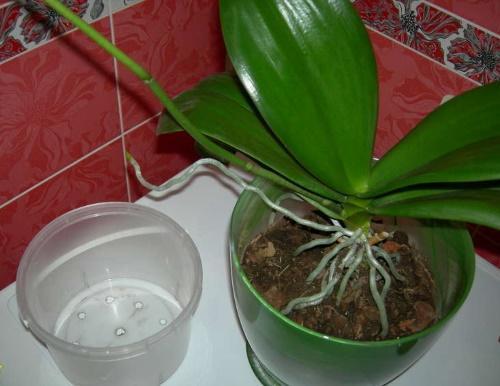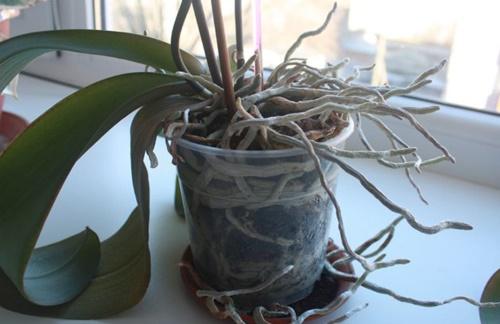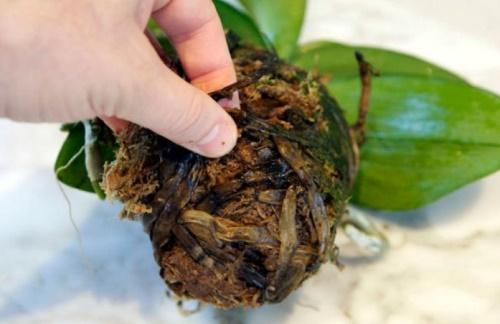When to transplant the phalaenopsis orchid: timing and features of the procedure
 Phalaenopsis is the pride of flower growers, because not all of them take root and bloom every year. These plants not only look different, but develop differently than other indoor flowers. If you also decide to acquire an exotic beauty, you should carefully study the information on how to take care of her. In addition, it does not hurt to know how and when to transplant the phalaenopsis orchid. Although it grows rather slowly, there comes a time when the epiphyte needs more space. You should also take into account the characteristics of the substrate in which the orchids live, because the bark gradually decomposes and loses its properties. Without a timely transplant, the roots begin to rot from waterlogging. So, what should you pay attention to to prevent this and how to properly transplant an orchid?
Phalaenopsis is the pride of flower growers, because not all of them take root and bloom every year. These plants not only look different, but develop differently than other indoor flowers. If you also decide to acquire an exotic beauty, you should carefully study the information on how to take care of her. In addition, it does not hurt to know how and when to transplant the phalaenopsis orchid. Although it grows rather slowly, there comes a time when the epiphyte needs more space. You should also take into account the characteristics of the substrate in which the orchids live, because the bark gradually decomposes and loses its properties. Without a timely transplant, the roots begin to rot from waterlogging. So, what should you pay attention to to prevent this and how to properly transplant an orchid?
When to transplant Phalaenopsis orchid

- Through the walls of the pot you can see that it is completely filled with roots, and from above substrate begins to "swell" with tubercles. This is cramped for the roots and they stick out the soil from the pot.
- The leaves began to turn yellow, and not only the "old" lower ones. The cause may be a disease, so it is better to change the soil.
- Roots, both aerial and those in the substrate, dry out or rot (turn black). Most often this occurs from a lack or excess of moisture, in addition, in most cases, fungal infections are present. Without a transplant, the orchid will die.
The acquired young orchids, provided that they are healthy, can stay in the same substrate for up to 2 years. But you should not keep them longer than this time, even if everything is fine with the flower. In a couple of years, the bark begins to decompose, it dries out longer, which is fraught with root rot.
 It is best to transplant phalaenopsis after flowering so that it does not lose its buds. If the plant has not bloomed, the best time for the procedure is early spring, when it forms new leaves. As soon as a small leaf has hatched in the center of the outlet, you can start transplanting.
It is best to transplant phalaenopsis after flowering so that it does not lose its buds. If the plant has not bloomed, the best time for the procedure is early spring, when it forms new leaves. As soon as a small leaf has hatched in the center of the outlet, you can start transplanting.
You can not transplant an orchid in summer, when it is too hot, and in winter, during a dormant period. The exception is cases of epiphytic disease.
How to transplant phalaenopsis
 Transplanting most often means simply replacing the soil with fresh, but at the same time without replacing the pot. An orchid does not need spacious flowerpots - it will bloom earlier in a cramped pot. It is enough just to wash the old flowerpot well. But it so happens that the rosette since the last transplant has become too large and has grown a lot of leaves. Then it makes sense to take a container slightly larger than the previous one.
Transplanting most often means simply replacing the soil with fresh, but at the same time without replacing the pot. An orchid does not need spacious flowerpots - it will bloom earlier in a cramped pot. It is enough just to wash the old flowerpot well. But it so happens that the rosette since the last transplant has become too large and has grown a lot of leaves. Then it makes sense to take a container slightly larger than the previous one.
For a large phalaenopsis, a flowerpot with a diameter of 12 to 15 cm is enough.
To transplant an orchid, it must be carefully removed from the pot along with the substrate, squeezing the walls of the vessel. Then, pick up the remnants of the bark with your hands, examine the roots. If there are dry, like strings - cut, they are already lifeless, slippery and soft - also remove, these are rotting.In the latter case, treatment with a fungicide is imperative so that the disease does not spread further. After it, the orchid should dry well for at least a couple of hours.
Pour fresh bark into a new or washed pot on the bottom, set the outlet in the center and fill in all the voids, securing it. The first watering of the transplanted phalaenopsis is best done in 2 days, and it will be possible to feed it only in a month.